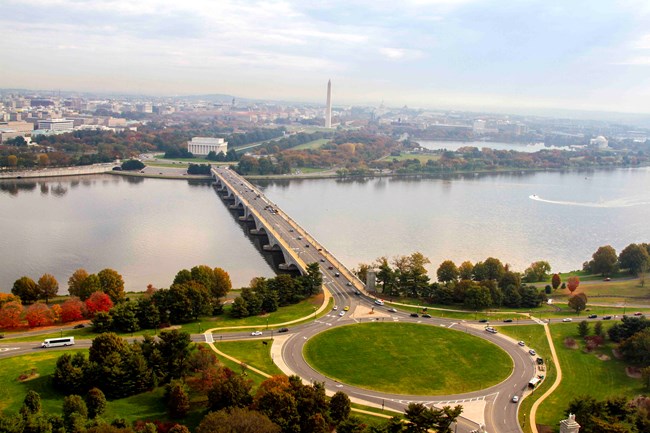
NPS 5 Reasons Why George Washington is a Role Model of Sustainability The George Washington Memorial Parkway is more than just a road. This National Park covers 7,300 acres (5,500 football fields!) connecting many historic sites and ecologically important native ecosystems. The National Park Service carries out its mission to preserve and protect these important cultural and natural resources. Unfortunately, climate change due to human activity is posing a threat to these resources. 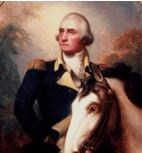
NPS Everyone knows George Washington as the first president and commander in chief, and the face on the $1 bill. But how about the Face of Sustainability? George Washington was not only an architect for a new form of government; he was also a pioneer of environmentally-conscious values. 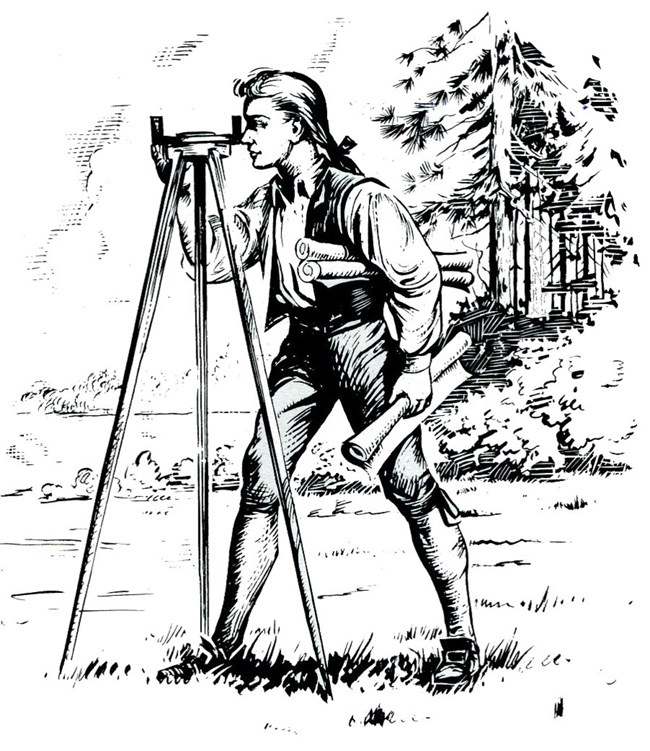
NPS
By the time Washington was seventeen, he was already an established county surveyor exploring the frontier. He had a special ability to select the best plots of land. He recognized the importance of the natural ecosystems which provided useful services and a sense of place. Washington paid close attention to the scenic beauty of trees, rivers, plants, and animals in an area as he surveyed new lands at the frontier. His awareness of the land’s value was beneficial in order to conserve natural resources.
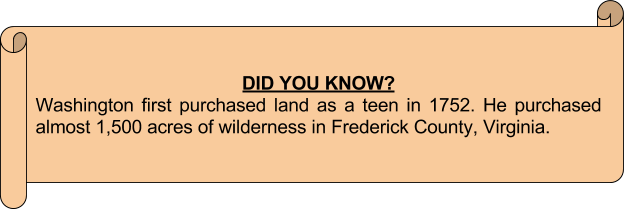
What can we learn? Washington’s perceptiveness, perfected during his first career, proved valuable both on the battlefield and beyond. By channeling his natural insight towards the resources at GWMP, visitors can fully appreciate sites such as the scenic waterfront recreation area of Jones Point and the rare plant communities at Great Falls.
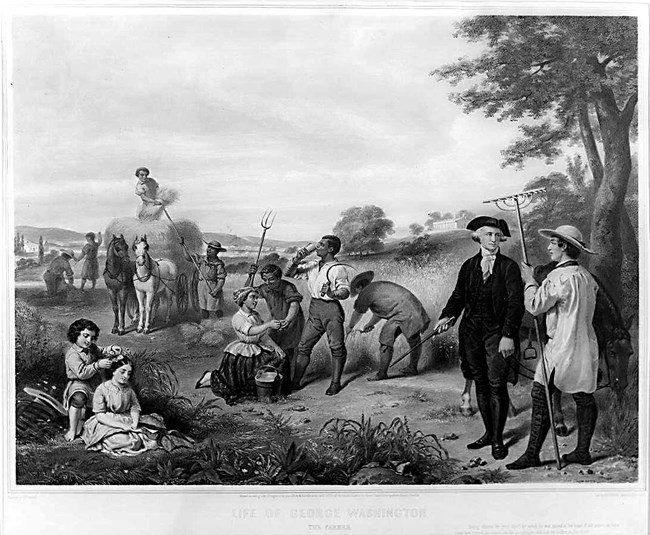
Library of Congress Washington strove to make Mount Vernon a model farm. He wanted America to be a leader in agriculture and looked for new techniques that made better use of the land. In his lifetime he obtained and bought 7600 acres of fertile land around Mount Vernon and managed it with sustainable farming practices. Most farmers at the time grew tobacco for profit, which was known to exhaust the soil. Instead of preserving land, farmers had to continuously find new plots. Washington chose to grow wheat in rotation with other crops (such as corn, rye, barley, legumes and grasses) which allowed nutrients to return to the soil. He chose the long-term health of the land over immediate profits. 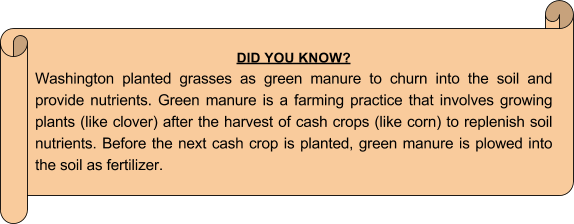
What can we learn? Washington’s approach to agriculture serves as an example for building sustainable businesses and applying environmentally aware practices. Agriculture was a large part of his life, and Washington made sure that he approached his work with a long-term vision that made use of innovative technologies and ideas. “[The Potomac’s] margin is washed by more than ten miles of tidewater; from the bed of which, and the enumerable coves, inlets & small marshes with which it abounds, an inexhaustible fund of rich mud may be drawn as a manure; either to be used separately, or in a compost, according to the Judgment of the farmer.” Letter from George Washington to Arthur Young December 12, 1793
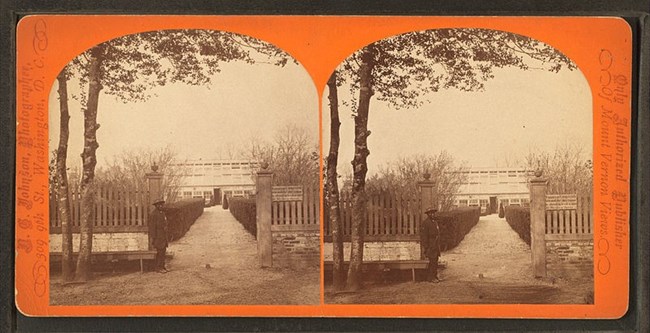
New York Public Library These efforts reflected a “naturalistic”—mirroring nature—philosophy of organizing outdoor spaces. Washington was known for working alongside his laborers to achieve his vision of the estate and such a commitment was ahead of his time.
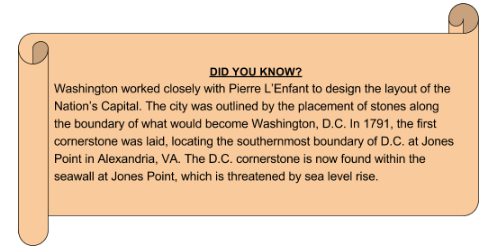
What can we learn? Even in the comfort of his home with friends and family, Washington was very thoughtful about the nature that surrounded him. His work reflected an appreciation of the natural world for more than just appearance. This respect for nature was one of his most important principles. It is shared by the NPS in its mission to preserve and protect natural resources. Mount Vernon is an example of inspiration for designing our homes and communities in ways that embody a commitment to nature’s well-being.
Letter from George Washington to Arthur Young December 12, 1793 4. He had a deep interest in science. He was passionate about the natural sciences, promoted new technology, and relied on scientific methods. Washington saw the value of science and scientific advancement. He studied local fossils to gain insights into natural history and promoted air ballooning technology developed in France. He was accepted into the American Philosophical Society, a leading institution for natural sciences. Washington viewed both art and science as: “...essential to the prosperity of the state and to the ornament and happiness of human life.” George Washington to Joseph Reed, Morristown New Jersey, February 15, 1780 Along with conducting experiments with fertilizer, he experimented with tallow and wax candles to determine which was best for lighting and cost. He was also a devout Anglican and his religious beliefs coexisted with a devotion to science. 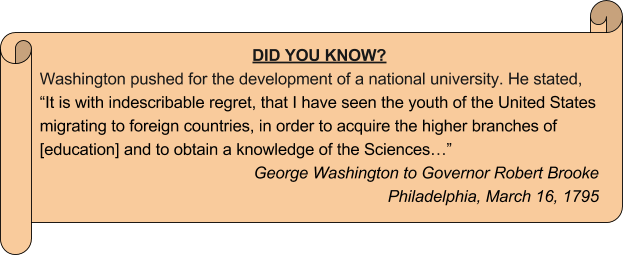
What can we learn? Washington truly believed in science and did not let religious or political bias cloud his scientific judgement. A percentage of Americans today may not accept climate change although there is overwhelming scientific consensus that humans have increased the rate of climate change. Also, Washington wrote about the need to embrace a system of education in the new United States and sought to include science as a key to success. A strong understanding of the role of science in society is crucial for responding well to climate change.
5. He was an effective leader with a strong character. He had a steady character and firm values that encouraged discipline, efficiency and unity leading to victory on the battlefield. 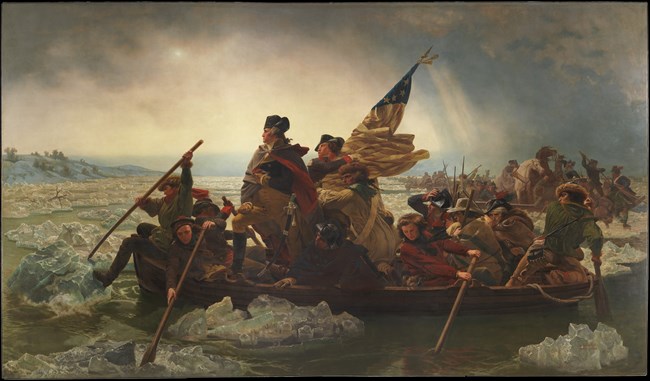
Metropolitan Museum of Art What can we learn? Personal and societal changes may need to occur in order to prevent further climate change. Change would involve reducing emissions and incorporating sustainable business practices. By adopting greater efficiency and discipline, society may be better equipped to fight climate change. Washington shows that it is possible to make dramatic changes necessary to confront an opponent, which also holds true for climate change as society’s greatest threat.
George Washington
Special thanks to Mary Thompson George Washington Research Historian
References
Gardner, A. G. (2013, Winter). How did Washington make his millions? Retrieved August 1, 2016, from https://www.history.org/Foundation/journal/winter13/washington.cfm
George Washington and agriculture. (n.d.). Retrieved from http://www.mountvernon.org/digital-encyclopedia/article/george-washington-and-agriculture/
Goodreads Inc. (n.d.). George Washington quotes. Retrieved from https://www.goodreads.com/author/quotes/4356.George_Washington
Johnson, N. G. (1800). South gate entrance to flower garden and conservatory, Mt. Vernon. [Digital image of George Washington's greenhouse]. Retrieved from https://commons.wikimedia.org/wiki/File:South_gate_entrance_to_flower_garden_and_conservatory,_Mt._Vernon,_by_N._G._Johnson.png
Junius Brutus Stearns, J. (1853). Life of George Washington--The farmer [Digital image of Washington standing among African-American fieldworkers harvesting grain; Mt. Vernon in background.]. Retrieved from https://commons.wikimedia.org/wiki/File:Washington_farmer.jpg
Key facts about George Washington. (n.d.). Retrieved from http://www.mountvernon.org/george-washington/key-facts/
Leutze, E. (1851). Washington Crossing the Delaware [Digital image of the painting of George Washington crossing the Delaware]. Retrieved from https://commons.wikimedia.org/wiki/File:Emanuel_Leutze_(American,_Schwäbisch_Gmünd_1816–1868_Washington,_D.C.)_-_Washington_Crossing_the_Delaware_-_Google_Art_Project.jpg
National Park Service. (n.d.). Park mission. Retrieved from https://www.nps.gov/gwmp/learn/management/index.htm
National Park Service. (n.d.). The American Revolution: George Washington. Retrieved from https://www.nps.gov/revwar/about_the_revolution/george_washington.html
National Park Service. (n.d.). Young George Washington [Digital image of the ink sketch of young George Washington surveying the area around the Popes Creek plantation]. Retrieved from https://commons.wikimedia.org/wiki/File:Young_George_Washington.jpg
Oklahoma Cooperative Extension Service, Oklahoma Department of Agriculture, Food and Forestry, & Oklahoma State Department of Education. (n.d.). George Washington on the farm. Retrieved from http://www.clover.okstate.edu/fourh/aitc/lessons/gwonfarm.pdf
Ten facts about the landscape at Mount Vernon. (n.d.). Retrieved from http://www.mountvernon.org/the-estate-gardens/gardens-landscapes/ten-facts-about-the-landscape-at-mount-vernon/ Thompson, M. (2016, July 21). George Washington's Life [Personal interview] |
Last updated: October 19, 2017
